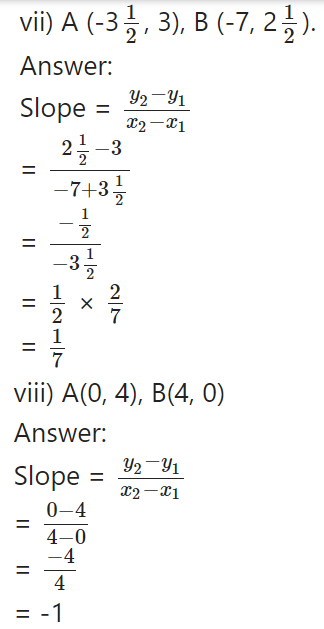Question 1.
Find the distance between the following pair of points,
(i) (2, 3) and (4, 1)
Answer:
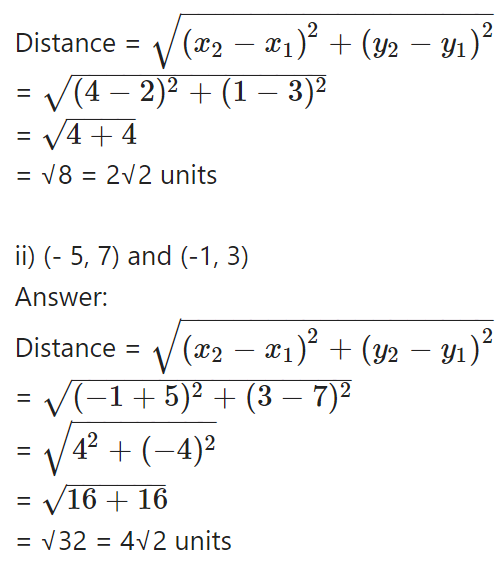
iii) (- 2, -3) and (3, 2)
Answer:
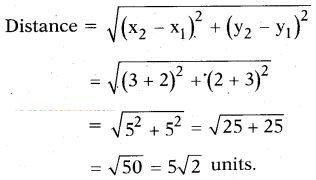
iv) (a, b) and (- a, - b)
Answer:
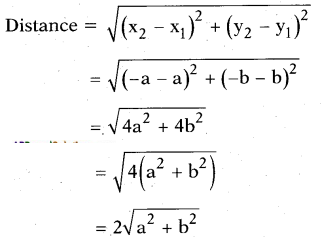
Question 2.
Find the distance between the points (0, 0) and (36, 15).
Answer:
Given: Origin O (0, 0) and a point P (36, 15).
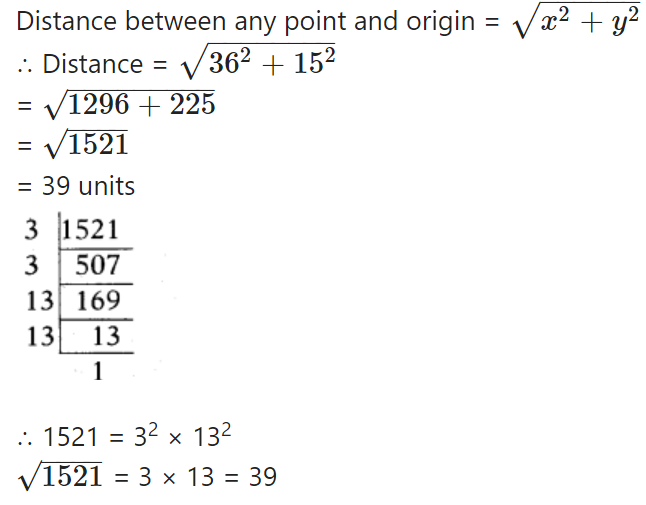
Question 3.
Verify that the points (1, 5), (2, 3) and (-2, -1) are collinear or not.
Answer:
Given: A (1, 5), B (2, 3) and C (- 2, - 1)
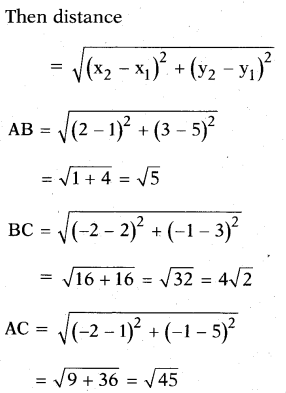
Here the sum of no two segments is equal to third segment.
Hence the points are not collinear.
!! Slope of AB, m1= 3-5/2-1 = -2
Slope of BC, m2 -1-3/-2-2 = 1
m1 ≠ m2
Hence A, B, C are not collinear.
Question 4.
Check whether (5, -2), (6, 4) and (7,-2) are the vertices of an isosceles triangle.
Answer:
Let A = (5, - 2); B = (6, 4) and C = (7, - 2).
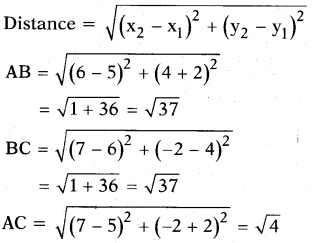
Now we have, AB = BC.
∴ △ABC is an isosceles triangle,
i.e., given points are the vertices of an isosceles triangle.
Question 5.
In a classroom, 4 friends are seated at the points A, B, C and D as shown in figure. Jarina and Phani walk into the class and after observing for a few minutes Jarina asks Phani “Don’t you think ABCD is a square?” Phani disagrees. Using distance formula, find which of them is correct. Why?
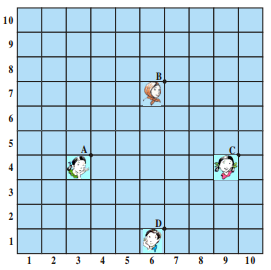
Answer:
Given: Four friends are seated at A, B, C and D where A (3, 4), B (6, 7), C (9, 4) and D (6, 1).
Now distance
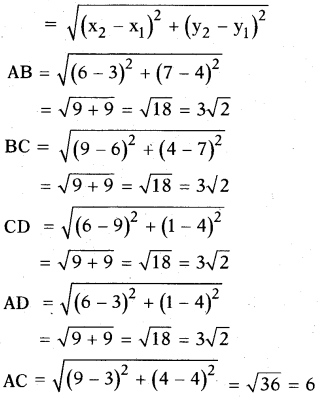

Hence in □ ABCD four sides are equal
i.e., AB = BC = CD = DA
= 3√2 units
and two diagonals are equal.
i.e., AC = BD = 6 units.
∴ □ ABCD forms a square.
i.e., Jarina is correct.
Question 6.
Show that the following points form an equilateral triangle A(a, 0), B(- a, 0), C(0, a√3).
Answer:
Given: A (a, 0), B (- a, 0), C (0, a√3).
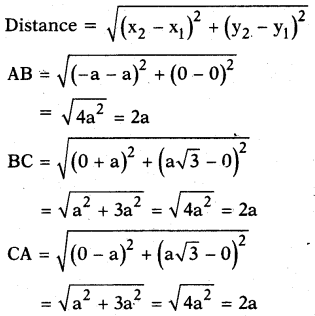
Now, AB = BC = CA.
∴ △ABC is an equilateral triangle.
Question 7.
Prove that the points (-7, -3), (5, 10), (15, 8) and (3, -5) taken in order are the corners of a parallelogram.
Answer:
To show that the given points form a parallelogram.
We have to show that the mid points of each diagonal are same. Since diagonals of a parallelogram bisect each other.
Now let A(-7, -3), B(5, 10), C(15, 8) and D(3, -5)
Then midpoint of diagonal
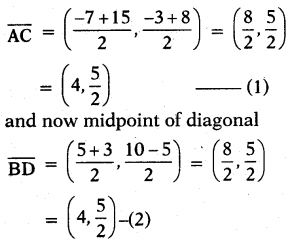
∴ (1) = (2)
Hence the given are vertices of a parallelogram.
Question 8.
Show that the points (-4, -7), (-1, 2), (8, 5) and (5, -4) taken in order are the vertices of a rhombus. And find its area.
(Hint: Area of rhombus = 1/2 × product of its diagonals)
Answer:
Given in ▱ ABCD , A(-4, - 7), B (- 1, 2), C (8, 5) and D (5,-4)
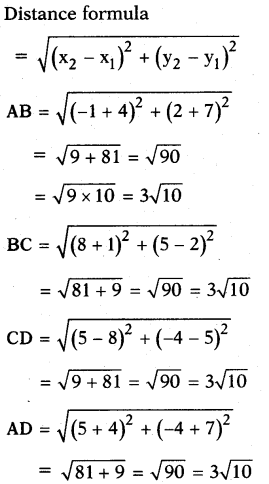
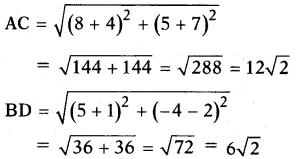
∴ In ▱ ABCD, AB = BC = CD = AD [from sides are equal]
Hence ▱ ABCD is a rhombus.
Area of a rhombus = 1/2 d1d2
= 1/2 × 12√2 × 6√2
= 72 sq. units.
Question 9.
Name the type of quadrilateral formed, if any, by the following points, and give reasons for your answer.
i) (-1,-2), (1,0), (-1,2), (-3,0)
Answer:
Let A (- 1, -2), B (1, 0), C (- 1, 2), D (- 3, 0) be the given points. Distance formula
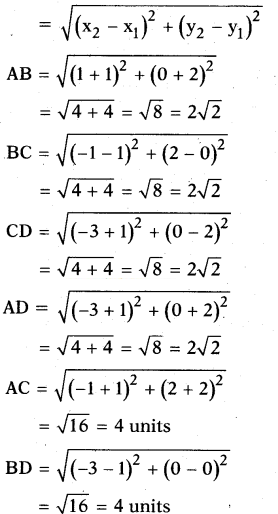
In ▱ ABCD, AB = BC = CD = AD - four sides are equal.
AC = BD - diagonals are equal.
Hence, the given points form a square,
ii) (-3, 5), (1, 10), (3, 1), (-1,-4).
Answer:
Let A(-3, 5), B(l,10), C(3, 1), D(-l, -4) then
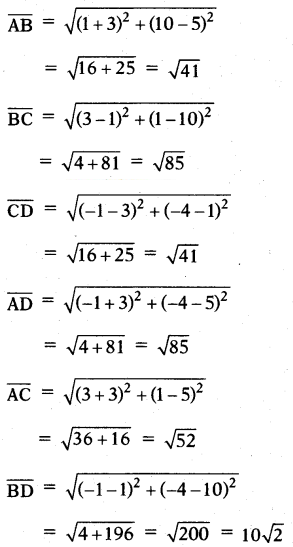

iii) (4, 5), (7, 6), (4, 3), (1, 2).
Answer:
Let A (4, 5), B (7, 6), C (4, 3) and D (1, 2) be the given points.
Distance formula
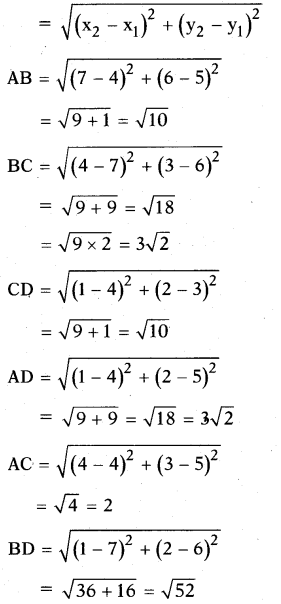
In ▱ ABCD, AB = CD and BC = AD (i.e., both pairs of opposite sides are equal) and AC ≠ BD.
Hence ▱ ABCD is a parallelogram, i.e., The given points form a parallelogram.
Question 10.
Find the point on the X-axis which is equidistant from (2, -5) and (-2,9).
Answer:
Given points, A (2, - 5), B (- 2, 9).
Let P (x, 0) be the point on X - axis which is equidistant from A and B. i.e., PA = PB.
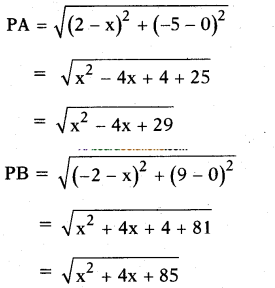
Squaring on both sides, we get
x2- 4x + 29 = x2+ 4x + 85
⇒ - 4x - 4x = 85 - 29
⇒ - 8x = 56
⇒ x = -56/8 = -7
∴ (x, 0) = (- 7, 0) is the point which is equidistant from the given points.
Question 11.
If the distance between two points (x, 7) and (1, 15) is 10, find the value of x.
Answer:
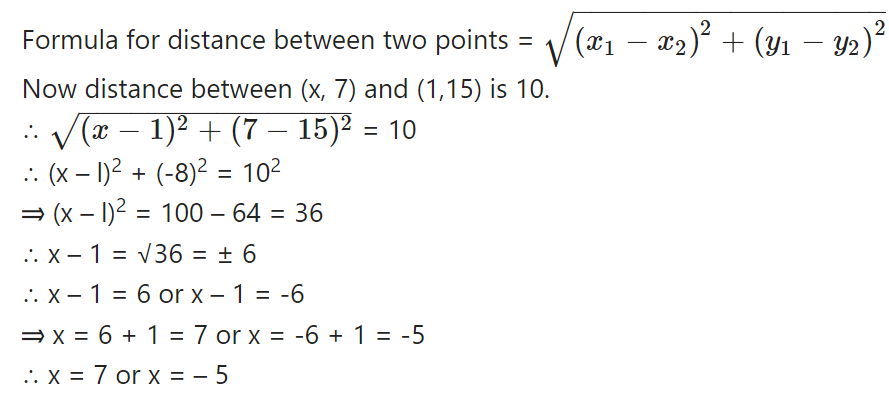
Question 12.
Find the values of y for which the distance between the points P(2, -3) and Q(10, y) is 10 units.
Answer:
Given: P (2, - 3), Q (10, y) and
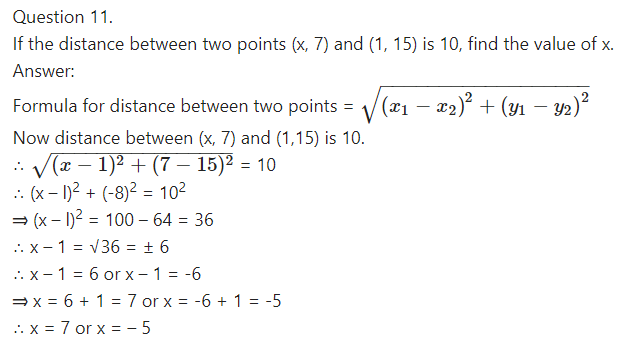
⇒ y2+ 6y + 73 = 100
⇒ y2+ 6y - 27 = 0
⇒ y2+ 9y - 3y - 27 = 0
⇒ y (y + 9) - 3 (y + 9) = 0
⇒ (y + 9) (y - 3) = 0
⇒ y + 9 = 0 or y - 3 = 0
⇒ y = -9 or y = 3
⇒ y = - 9 or 3.
Question 13.
Find the radius of the circle whose centre is (3, 2) and passes through (-5,6).
Answer:
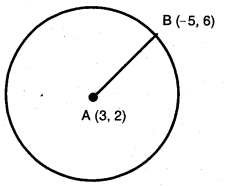
Given: A circle with centre A (3, 2) passing through B (- 5, 6).
Radius = AB
[∵ Distance of a point from the centre of the circle]

Question 14.
Can you draw a triangle with vertices (1, 5), (5, 8) and (13, 14)? Give reason.
Answer:
Let A (1, 5), B (5, 8) and C (13, 14) be the given points.
Distance formula
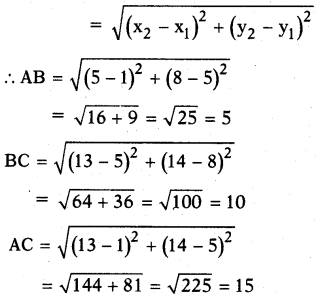
Here, AC = AB + BC.
∴ △ABC can’t be formed with the given vertices.
[∵ Sum of the any two sides of a triangle must be greater than the third side].
Question 15.
Find a relation between x and y such that the point (x, y) is equidistant from the points (-2, 8) and (-3, -5).
Answer:
Let A (- 2, 8), B (- 3, - 5) and P (x, y). If P is equidistant from A, B, then PA = PB.
Distance formula =
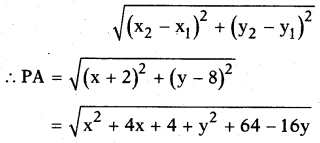
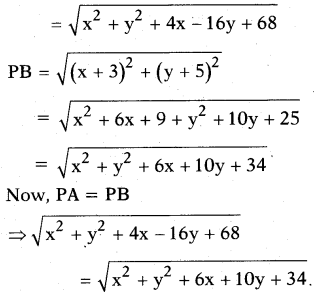
Squaring on both sides we get, x2+ y2+ 4x - 16y + 68
= x2+ y2+ 6x +10y + 34
⇒ 4x - 16y - 6x - 10y = 34-68
⇒ - 2x - 26y = -34
⇒ x + 13y = 17 is the required condition.
Question 1.
Find the coordinates of the point which divides the line segment joining the points (-1, 7) and (4, -3) in the ratio 2 :3.
Answer:
Given points P (-1, 7) and Q (4, - 3). Let ‘R’ be the required point which divides PQ in the ratio 2:3. Then
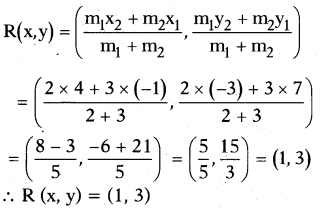
Question 2.
Find the coordinates of the points of trisection of the line segment joining (4, -1) and (-2, -3).
Answer:
Given points A (4, - 1) and B (- 2, - 3) Let P and Q be the points of trisection
of AB, then AP = PQ = QB.

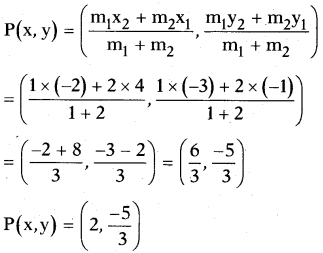
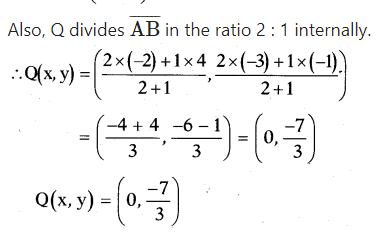
Question 3.
Find the ratio in which the line segment joining the points (-3, 10) and (6, -8) is divided by (-1, 6).
Answer:
Let the point (-1, 6) divides the line segment joining the points (-3, 10) and (6, -8) in a ratio of m : n
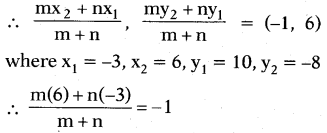
⇒ 6m - 3n = -(m + n) = -m - n
⇒ 6m + m = - n + 3n
⇒ 7m = 2n
⇒ m/n = 2/7
⇒ m : n = 2 : 7
∴ The point (-1, 6) divides the given line segment in a ratio of 2 : 7.
Question 4.
If (1, 2), (4, y), (x, 6) and (3, 5) are the vertices of a parallelogram taken in order, find x and y.
Answer:

Given: ▱ ABCD is a parallelogram where A (1, 2), B (4, y), C (x, 6) and D (3, 5).
In a parallelogram, diagonals bisect each other.
i.e., the midpoints of the diagonals coincide with each other.
i.e.,midpoint of AC = midpoint of BD
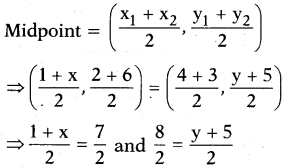
⇒ 1 + x = 7 and 8 = y + 5
⇒ x = 7 - 1 and y = 8 - 5
∴ x = 6 and y = 3.
Question 5.
Find the coordinates of a point A, where AB is the diameter of a circle whose centre is (2, -3) and B is (1, 4).
Answer:
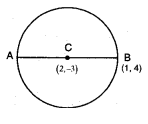
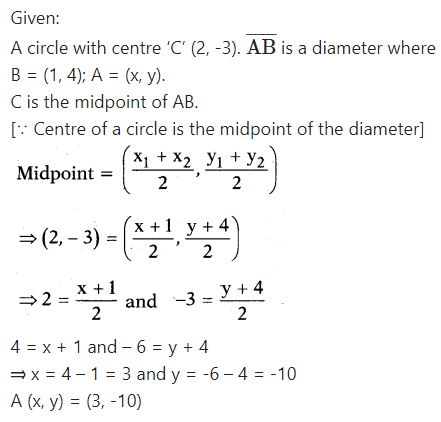
4 = x + 1 and - 6 = y + 4
⇒ x = 4 - 1 = 3 and y = -6 - 4 = -10
A (x, y) = (3, -10)
Question 6.
If A and B are (-2, -2) and (2, -4) respectively. Find the coordinates of P such that AP = 3/7 AB and P lies on the segment AB.
Answer:
Given: A (- 2, - 2) and B (2, - 4)
P lies on AB such that AP = latex]frac{3}{7}[/latex] AB
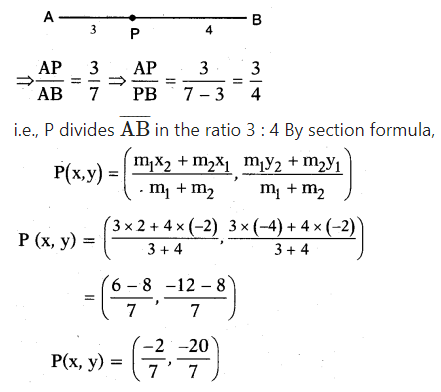
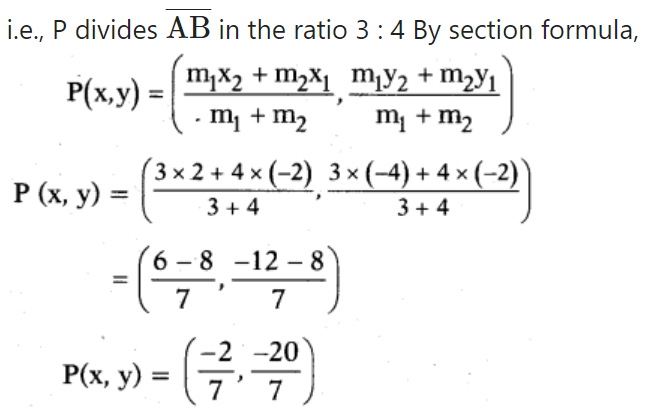
Question 7.
Find the coordinates of points which divide the line segment joining A (-4, 0) and B (0, 6) into four equal parts.
Answer:
Given, A (- 4, 0) and B (0, 6).
Let P, Q and R be the points which divide AB into four equal parts.

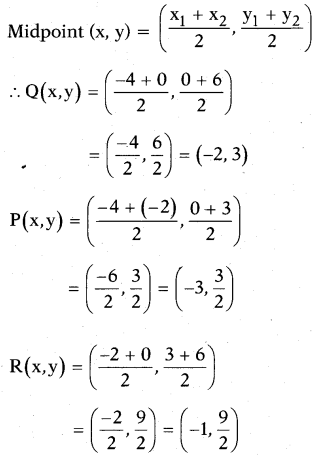
Question 8.
Find the coordinates of the points which divides the line segment joining A(-2, 2) and B(2, 8) into four equal parts.
Answer:
Given, A (- 2, 2) and B (2, 8).
Let P, Q and R be the points which divide AB into four equal parts.


Question 9.
Find the coordinates of the point which divide the line segment joining the points (a + b, a-b) and (a-b, a + b) in the ratio 3 : 2 internally.
Answer:
Given : A (a + b, a - b) and B (a - b, a + b).
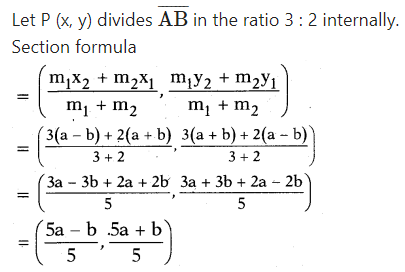
Question 10.
Find the coordinates of centroid of the triangle with following vertices:
i) (-1, 3), (6, -3) and (-3, 6)
Answer:
Given: △ABC in which- A (- 1, 3), B (6, -3) and C (-3, 6)
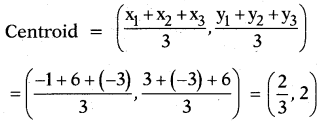
ii) (6, 2), (0, 0) and (4, -7)
Answer:
Given: The three vertices of a triangle are A (6, 2), B (0, 0) and C (4, – 7).
Centroid (x, y)
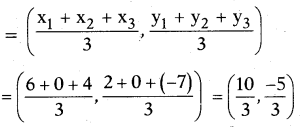
iii) (1,-1), (0, 6) and (-3, 0)
Answer:
Given: (1, -1), (0, 6) and (-3, 0) are the vertices of a triangle.
Centroid (x, y)
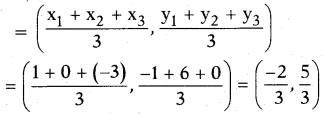
Question 1.
Find the area of the triangle whose vertices are
i) (2, 3), (-1, 0), (2,-4)
Answer:
Given: A (2, 3), B (- 1, 0) and C (2, -4) are the vertices of a △ABC.

ii) (-5, -1), (3, -5), (5, 2)
Answer:
Given: A (- 5, -1), B (3, -5) and C (5, 2) are the vertices of △ABC.
Area of the △ABC
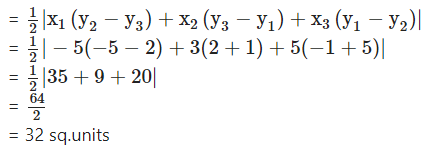
iii) (0, 0), (3, 0), (0, 2)
Answer:
Given: O (0, 0), A (3, 0) and B (0, 2) are the vertices of a triangle, △AOB.
Area of the △AOB

Or
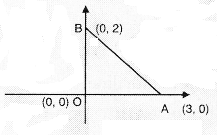
△AOB = 1/2 × OA × OB
= 1/2 × 3 × 2
= 3 sq.units
Question 2.
Find the value of ‘K’ for which the points are collinear.
i) (7, -2), (5, 1), (3, K)
Answer:
Given: A (7, - 2), B (5, 1) and C (3, K) are collinear.
∴ Area of △ABC = 0
But area of triangle
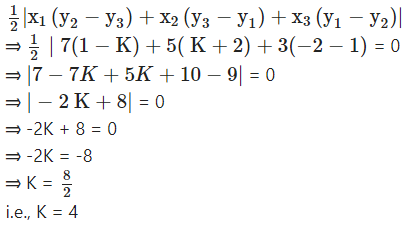
⇒ -2K + 8 = 0
⇒ -2K = -8
⇒ K = 8/2
i.e., K = 4
ii) (8, 1), (K,-4), (2,-5)
Answer:
Given: A (8, 1), B(K, - 4) and C (2, - 5) are collinear.
∴ Area of △ABC = 0
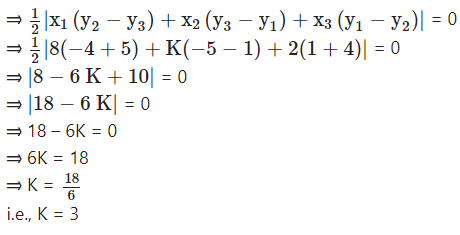
⇒ 18 - 6K = 0
⇒ 6K = 18
⇒ K = 18/6
i.e., K = 3
iii) (K,K), (2, 3), and (4,-1)
Answer:
A (K, K), B (2, 3) and C (4, - 1) are collinear.
∴ Area of △ABC = 0
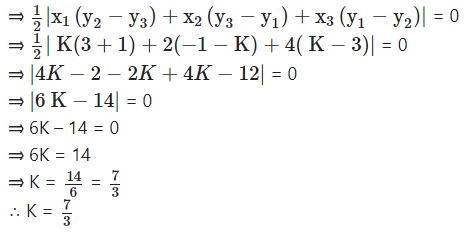
⇒ 6K - 14 = 0
⇒ 6K = 14
⇒ K = 14/6 = 7/3
∴ K = 7/3
Question 3.
Find the area of the triangle formed by joining the mid-points of the sides of the triangle whose vertices are (0, -1), (2, 1) and (0, 3). Find the ratio of this area to the area of the given triangle.
Answer:
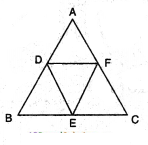
Given: A (0, - 1), B (2, 1) and C (0, 3) are the vertices of △ABC.
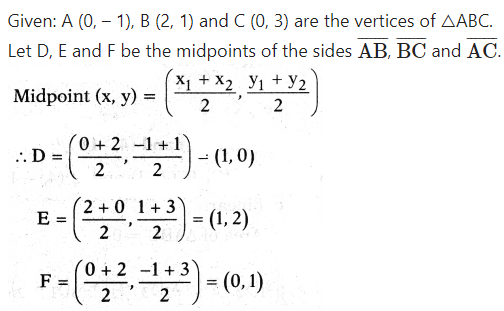

Question 4.
Find the area of the quadrilateral whose vertices taken inorder are (-4, -2), (-3, -5),(3, -2) and (2, 3).
Answer:
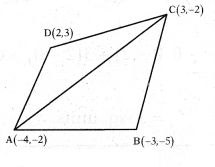
Given: A (- 4, - 2), B (- 3, - 5), C (3, - 2) and D (2, 3) are the vertices of the quadrilateral ▱ ABCD.
Area of ▱ ABCD = △ABC + △ACD.
Area of a triangle =

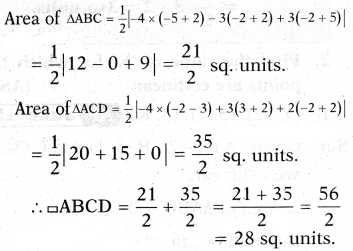
Question 5.
Find the area of the triangle formed by the points by using Heron’s formula.
i) (1, 1), (1, 4) and (5, 1)
ii) (2, 3), (-1,3) and (2, -1)
Answer:
i) (1, 1) (1, 4) and (5, 1)
let A (1, 1) B(l, 4) and C(5, 1) are the vertices then length of sides can be calculated using the formula
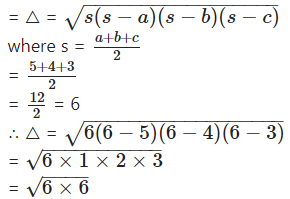
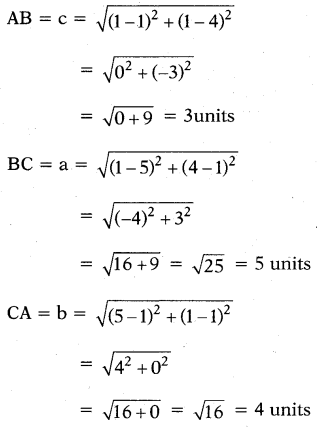

= 6 sq. units
∴ area of given triangle = 6 sq units
ii) let the vertices of given triangle A (2, 3), B (-l, 3) and C (2, -1)
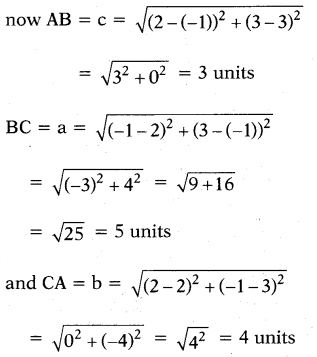
∴ a = 5, b = 4, c = 3 units
now from using Heron’s formula area of triangle
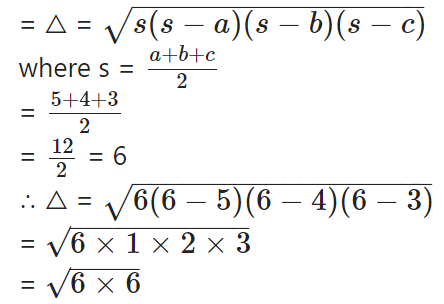
= 6 sq. units
∴ area of given triangle = 6 sq units
Question 1.
Find the slope of the line joining the two given points.
i) (4,-8) and (5,-2).
Answer:
Slope =y2-y1/x2-x1
=-2+8/5-4
= 6
ii) (0, 0) and (√3, 3)
Answer:
Slope = y2-y1/x2-x1
= 3-0/√3-0
= 3/√3
= √3×√3/√3
= √3
iii) (2a, 3b) and (a, -b).
Answer:
Slope = y2-y1/x2-x1
= -b-3b/a-2a
= -4b/-a
= 4b/a
iv) (a, 0) and (0, b).
Answer:
Slope = y2-y1/x2-x1
= b-0/0-a
= -b/a
v) A (-1.4, -3.7), B (-2.4, 1.3).
Answer:
Slope = y2-y1/x2-x1
= 1.3+3.7/-2.4+1.4
= 5.0/-1
= -5
vi) A (3, -2), B (-6, -2).
Answer:
Slope = y2-y1/x2-x1
= -2+2/-6-3
= 0
